A Summer in Le Havre
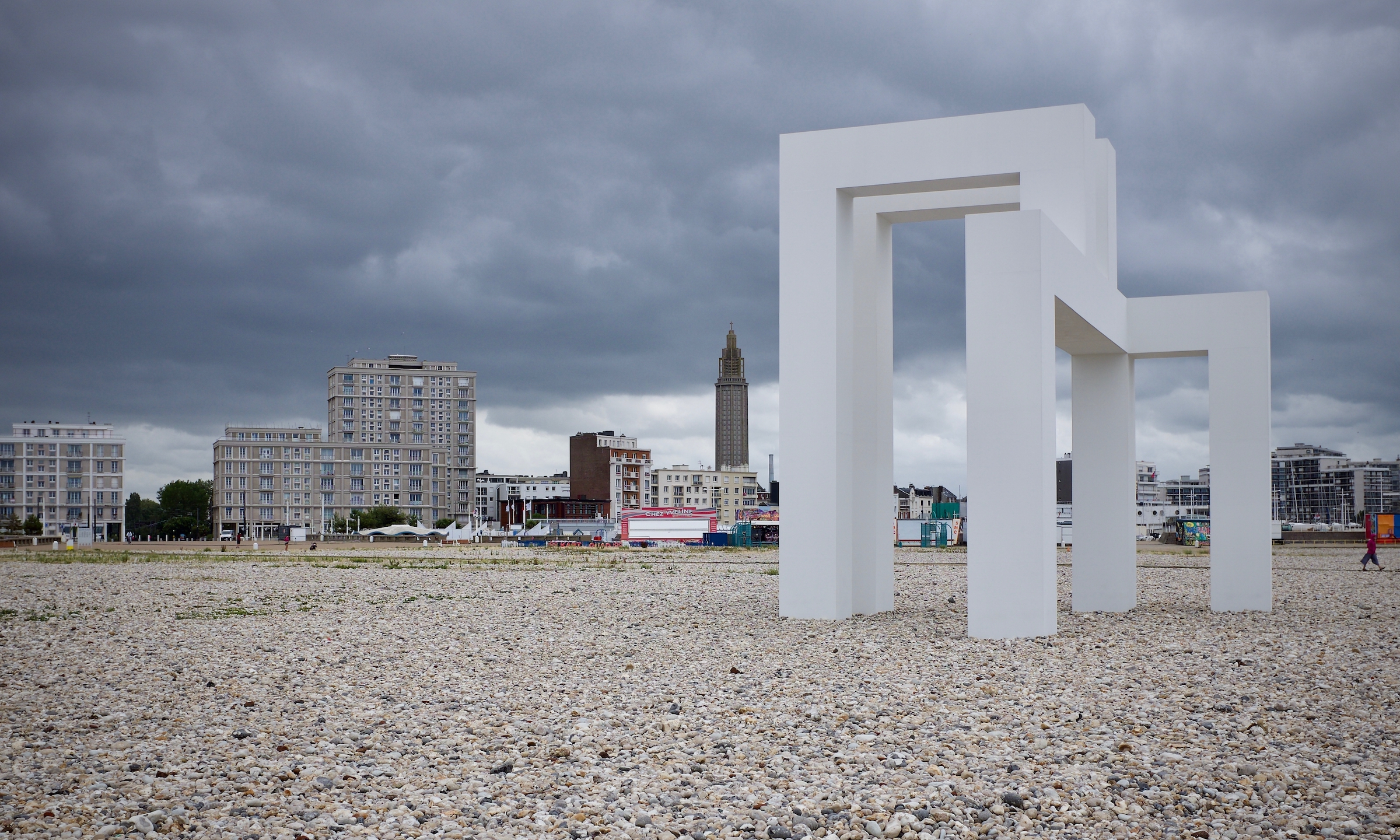
UP#3 (Lang/Baumann, 2017) on Le Havre’s stoney beach
I remember my friend James telling me once about what he calls the Ayres Rock effect. This is the situation in which somebody will describe their visit to Uluru as being magical and moving, thus setting expectations so high, that your own experience is underwhelming. Hearing your disappointment, subsequent visitors’ low expectations will ensure their own experience is one of wonder and joy. And so the cycle continues.
Having read Oliver Wainwright’s article in the Guardian, I fear the same may be true when describing Le Havre, a medium-sized coastal city in Normandy that lies at the mouth of the Seine. Flattened by German bombs in 1944, today it is home to a large container port and a dull, stoney beach that offers nothing but unobstructed views of cross-channel ferries. As such, it’s a curious destination for tourists, except perhaps those interested in urban renewal and modern architecture – or ferry spotting!

Canène de containers (Vincent Ganivet, 2017)
This year however there’s a more compelling reason to visit. To celebrate 500 years since its founding, Un Été au Havre (A Summer in Le Havre) sees the city host a festival of art and culture, with events, exhibitions and guided tours. A number of public spaces have been made home to dramatic installations, many of which would ideally become permanent.
Vincent Ganivet’s Canène de containers (Catenary of containers) and Lang/Baumann’s UP#3 are two such examples, both drawing your eye towards the points at which rue de Paris and Avenue Foch respectively reach their shoreline conclusion. They also sit at two corners of the triangular quarter rebuilt after the war.
Concrete chic
With an urban plan by Auguste Perret, this quarter is notable for its modular buildings that conform to a fixed grid of 6.24m. Constructed using reinforced concrete, you’ll find none of the brutalism associated with this building method. Wainwright called it concrete chic. I’m not sure I would go that far, but I certainly found examples where concrete had been used decoratively and imaginatively, particularly on the apartments lining Avenue Foch.
A criticism often levelled at concrete is that it can make buildings appear cold or inhumane. Thanks to the variety of finishes, textures, colours and fittings, as well as landscaping that features fountains, tree-lined boulevards, open spaces and quiet courtyards, Perret’s liveable quarter feels quite delicate, mellow even. Concrete rarely weathers well, and here, where it reaches its extremities, exposed and rusty rebar is a common sight. If this UNESCO World Heritage Site is to celebrate its first centenary, repairs will be needed.
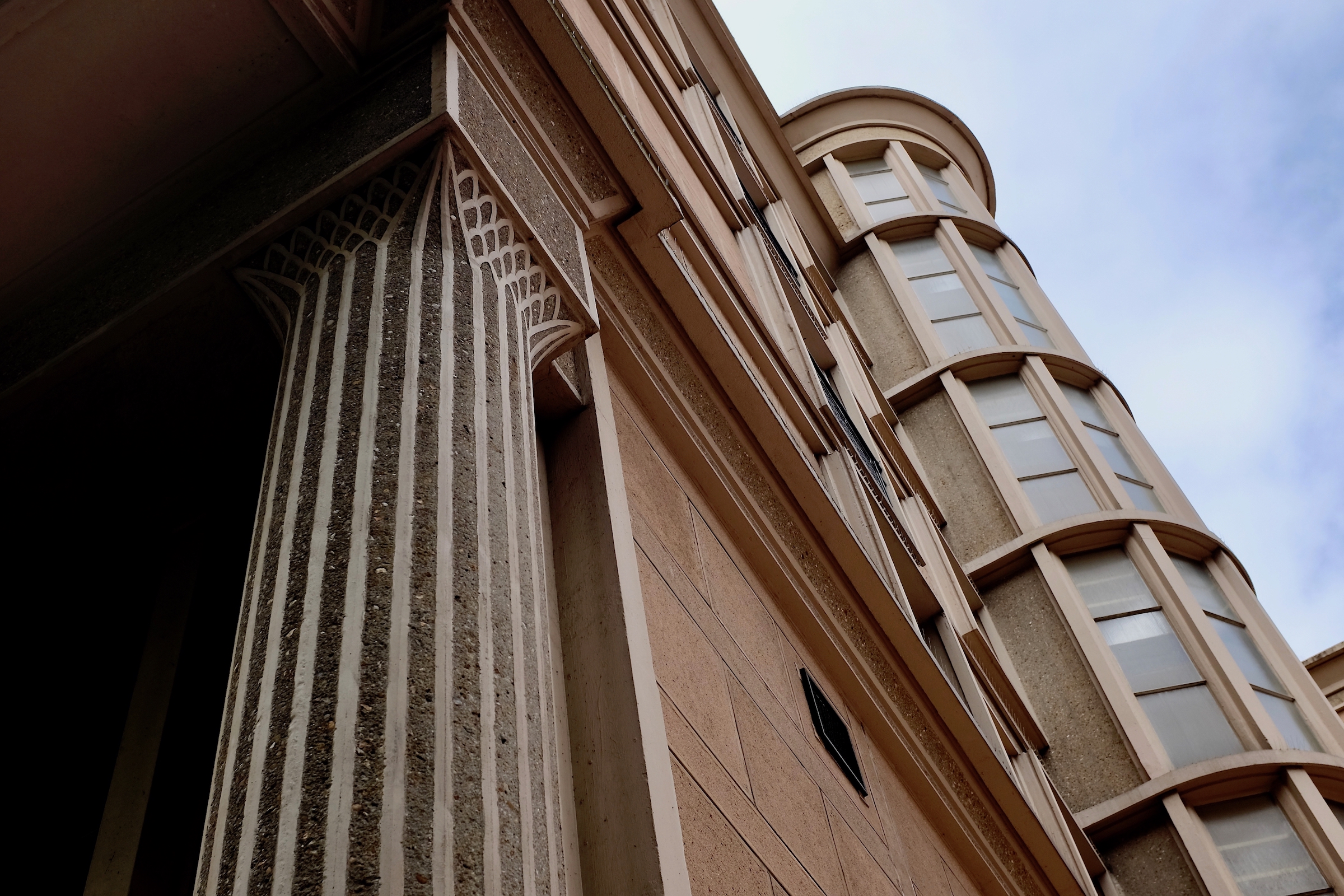
To see such detailing on a column made of concrete was quite unexpected
No such damage was to be found on the city’s unavoidable signature building, Saint Joseph’s Church. One of two buildings in the city designed by Perret, it looks like something from another planet. Its 170m-tall spire resembles Doctor Who’s sonic screwdriver, and entering the building is to be teleported to a temple on an alien planet. Climbing up one corner of the spire, a tightly wound staircase only intensifies its vertigo inducing effect. Thankfully, this wasn’t open to the public, saving me the torment of reluctantly climbing the damn thing. Also of note is Marguerite Huré’s stunning kaleidoscopic stained glass, whose various shades transition to white as they reach the top, enhance to this building’s already dizzying majesty.
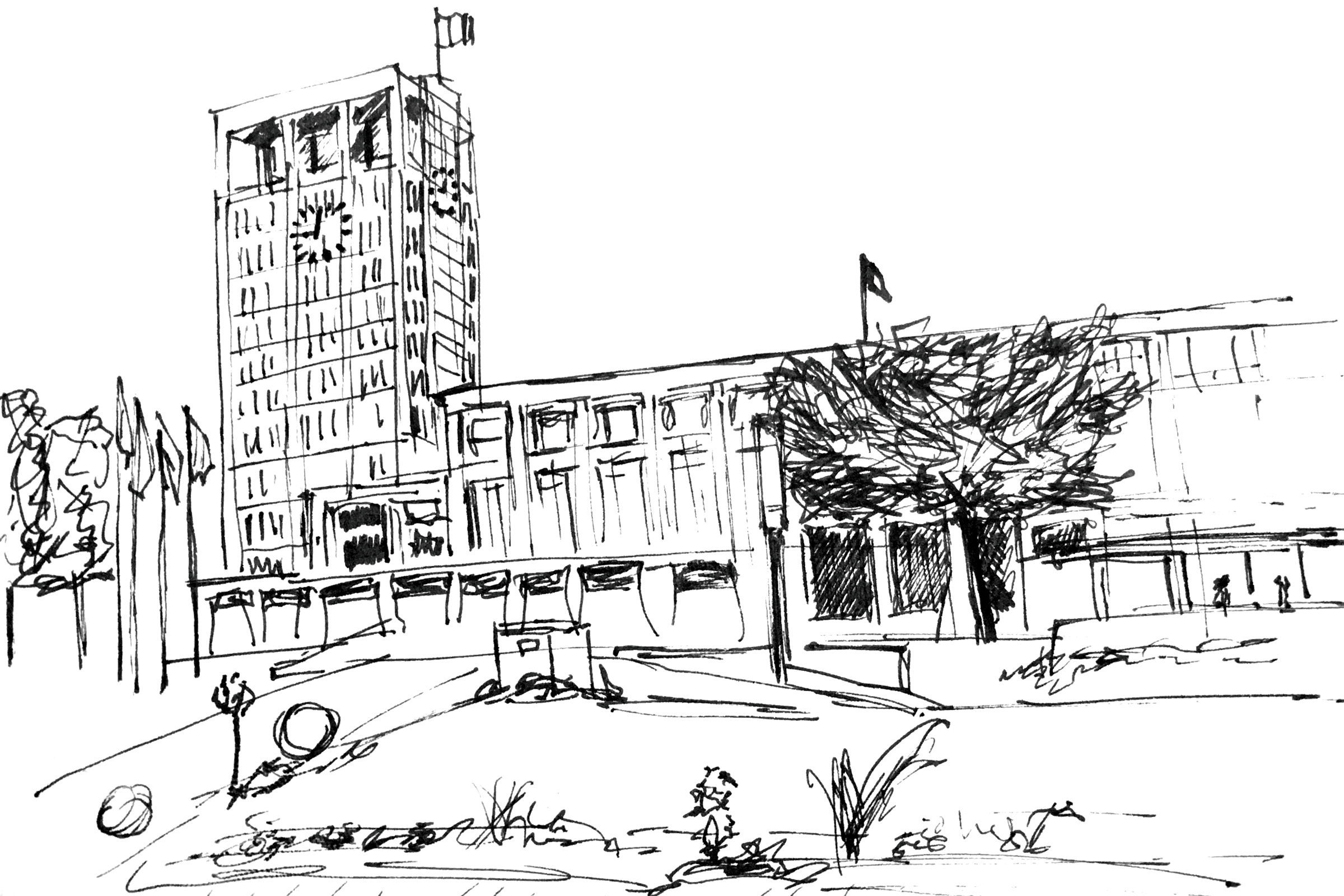
During my trip I took the time to sit down and draw. Here’s a quick sketch of Hôtel de Ville.
At the quarter’s apex is Hôtel de Ville (Town Hall), the second building designed by Perret, yet completed after his death. A modest landmark harbouring grander ambitions, its three storey high main structure is furnished with simple colonnades framing tall windows. On its western side, an 18 storey tower block with a clock face on each side, signifies this building’s relationship with the city.
Thankfully the carbuncle that is its northern extension is hidden from view of the public square that sits in front of the building. Here, a ‘timescope’ (a telescope-like device containing a VR experience) lets you to view the impressive Baroque building that stood prior to the war, and what remained of it after the bombing. Upsetting, to say the least. Outside Cathédrale Notre-Dame, one of the few buildings in this quarter that escaped damage, its adjacent square is set a meter lower than street level, a gesture that highlights how the surrounding buildings are built on the rubble of the former city.
It’s within this context that Perret’s plan should be viewed. While nothing can replace what existed before – other parts of the city give some indication as to what was lost – his plan seems to have struck a balance between invention and pragmatism. Visiting a show apartment, furnished as it would have originally appeared in the 1950s, demonstrates how every care was taken to provide residents with good quality, well apportioned living spaces. Compact yes, but by no means cramped.
In the shadow of Niemeyer
The other architecturally significant sight is that of the Le Volcan (The Volcano), designed by Oscar Niemeyer. His two sculpted white peaks bring welcome relief to the visitor tiring of rectangular buildings conforming to Perret’s rigid grid.
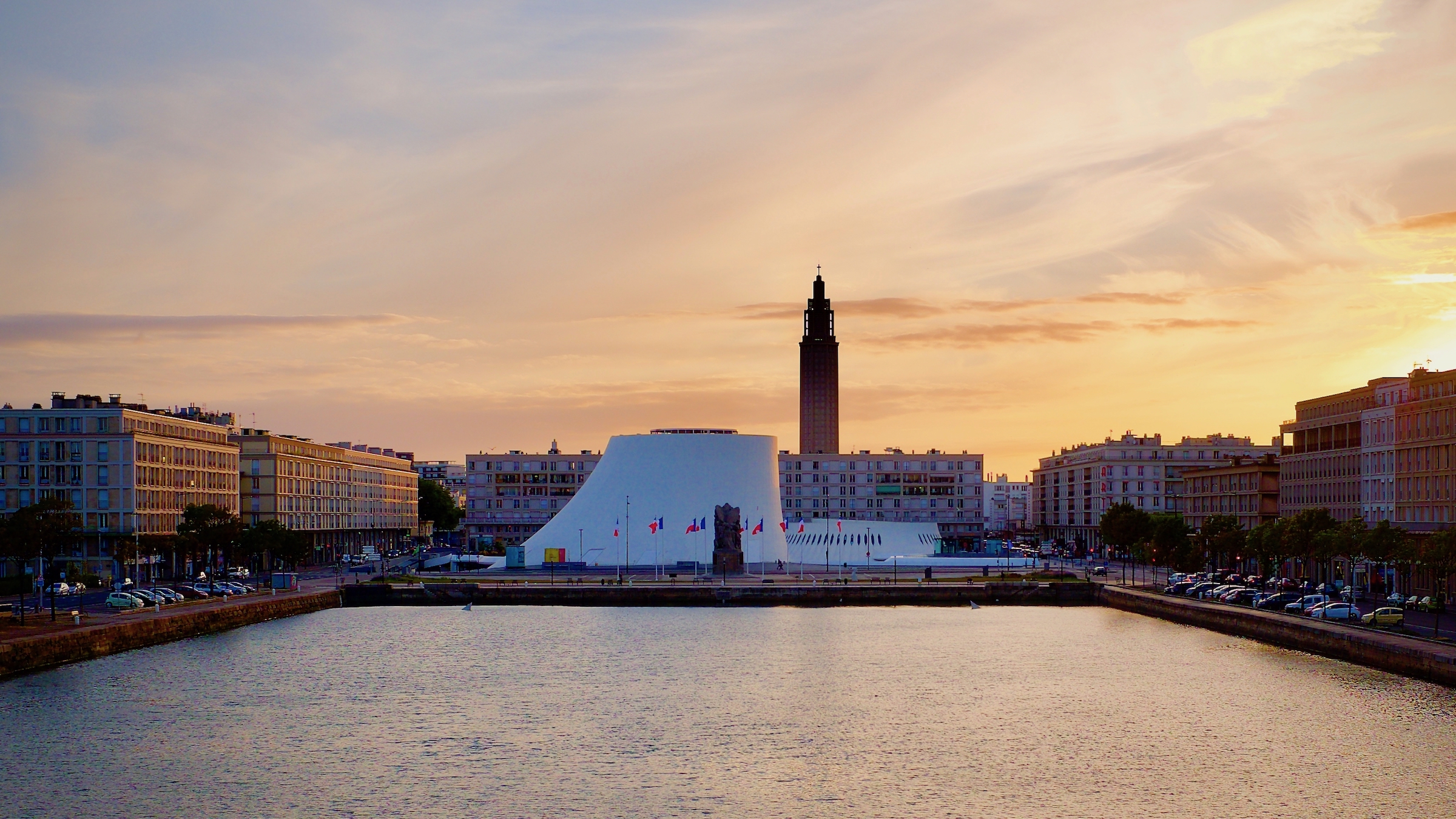
Le Volcan with Saint Joseph’s Church in the distance
Unlike his work in Brasília – a city built from nothing and where the imagination of its planners ran wild – here the destroyed city provided a foundation upon which the new layout was aligned. Important civic buildings remained in the locations they sat previously, and this complex sits where the former Grand-Théâtre stood. Niemeyer again defined his canvas from above, with the two peaks sitting either side of a sunken area whose walls, when viewed from the air, suggest the outline of a dove.
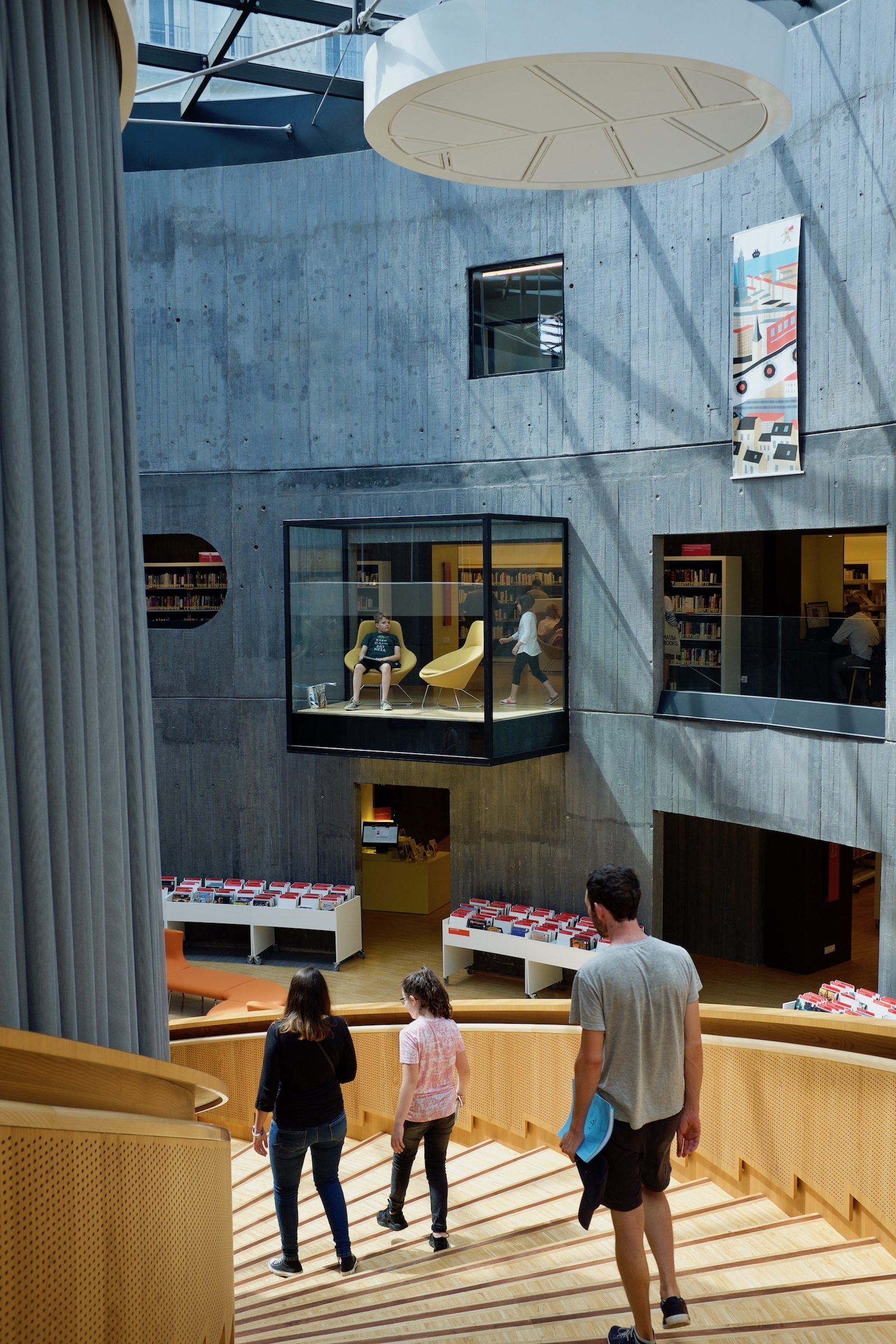
Bibliotheque Oscar Niemeyer
Like its larger sibling, the smaller of the two buildings was originally a performance venue. In 2015 it was reconfigured to serve as the city’s library. And oh my, what a library! Set among curvaceous spaces set below the public square above, from the entrance I found myself drawn through the body of the building towards a reading room bathed in light from its clear glass roof. A generous pine central staircase winds up to a second floor, from which readers (and people watchers) can sit in small glass boxes that reach out into this intriguing space.
At this point, it was hard not to feel envious of the citizens of Le Havre, who have a beautiful Oscar Niemeyer building all to themselves!
To the docks
Urban regeneration never stops, and so to an area of revitalised docks. Shorn of their industrial requirements, they have been given over to a shopping mall, university and swimming complex, among other uses. With such a wealth of waterside appointments, one might imagine this would be the most interesting and vibrant part of the city, yet it might as well have remained wasteland. A collection of bland boxes surrounding two basins, even its converted warehouses underwhelm. Indeed, the area’s most celebrated building, Des Bains de Docks was designed to be unassuming from outside. I’m sure this area will develop over time, but today, it serves only to contrast with what Perret and his team accomplished in more austere times.
Unexpected charm
Prior to my arrival, I had built up expectations of an entire city rebuilt to the plans of Auguste Perret, with Oscar Niemeyer’s beautiful volcanos just one of many architectural delights. I expected a scaled down version of Paris, with busy cafés surrounding the central square, restaurants on every corner.
Instead, I found a quiet, coastal city with a small modernist quarter whose spaciousness did little to disguise a declining population and deserted streets. Unlike Rotterdam, a Dutch city with a similar post-war history, there was no ‘starchitecture’ to be found. Nor could I find any bohemian, artistic outposts, or hipster coffee shops serving flat whites. Walking around the city on Sunday afternoon, the only noise was that of a gentle breeze rustling the rigging of fishing boats moored in the docks. That this wasn’t much different to any other day or time of the week, gives some indication how desolate parts of the city felt.
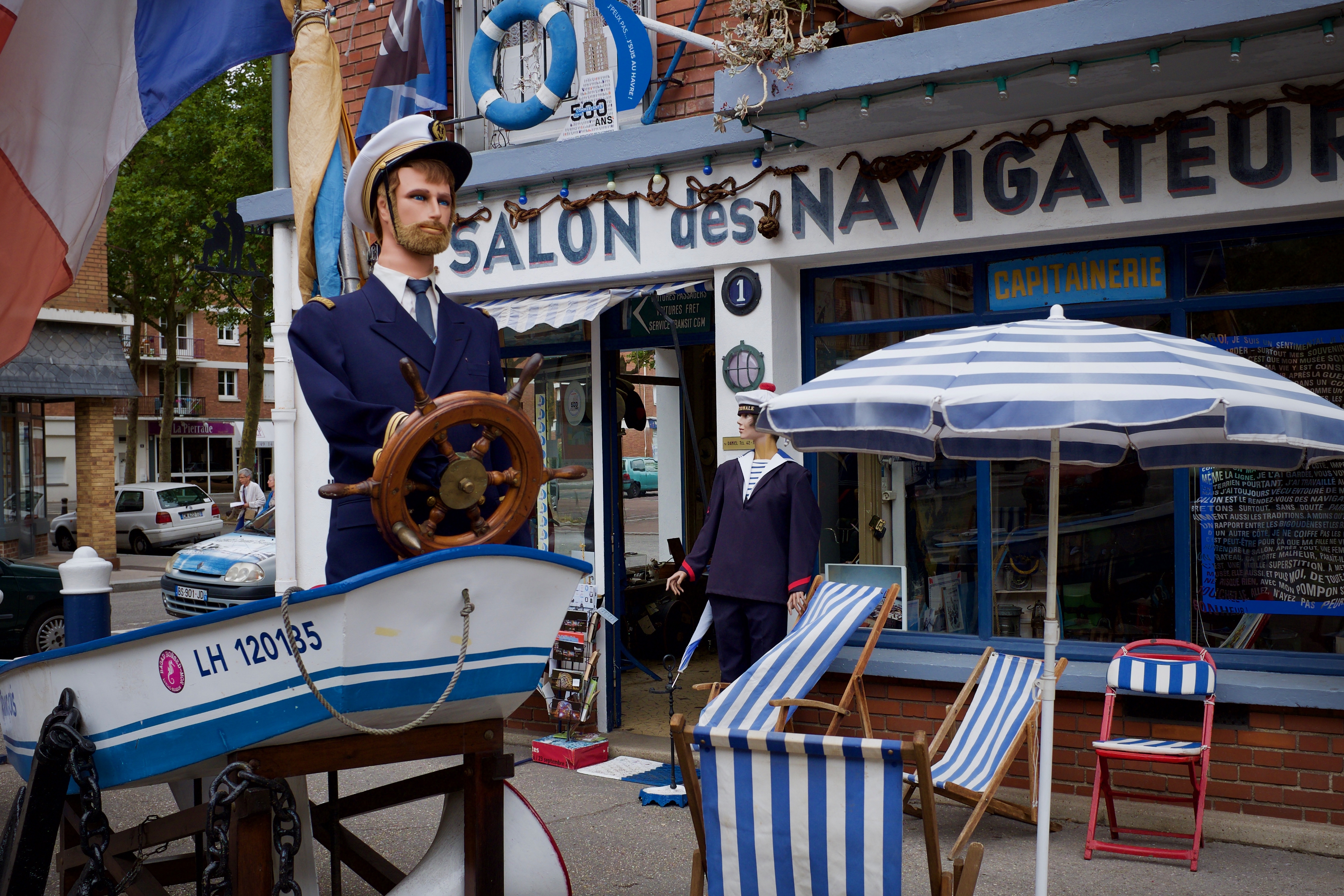
Salon des Navigateurs is all kinds of weird and wonderful
And yet, tucked away, a few gems could be found. The Seine at Samois, a captivating painting by Armand Guillaumin hanging in the Musée d’art moderne André Malraux. A short funicular railway that transported me to the higher (and largely unexplored) part of the city where the Tetris arts venue had a robot drawing portraits with a biro. Or the fish market decorated with murals of sea creatures and landscapes. And, most bizarrely, Salon des Navigateurs, a hair salon that is part maritime museum – and part horror show, frankly!
Le Havre is not a glamorous city, nor is it a vibrant, cosmopolitan city. But it is a city full of curiosity and surprise. Set your expectations accordingly.
Un Été au Havre runs until 8 October 2017.